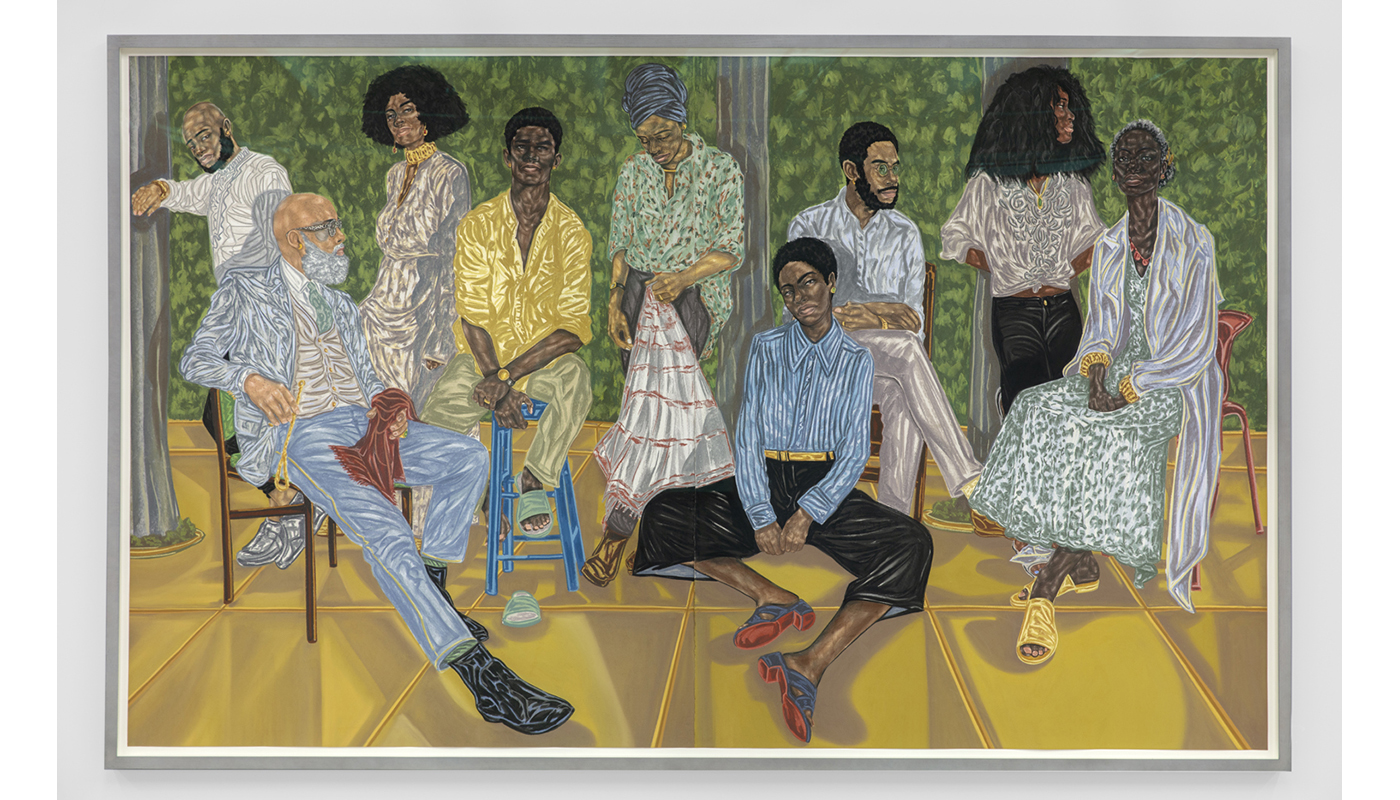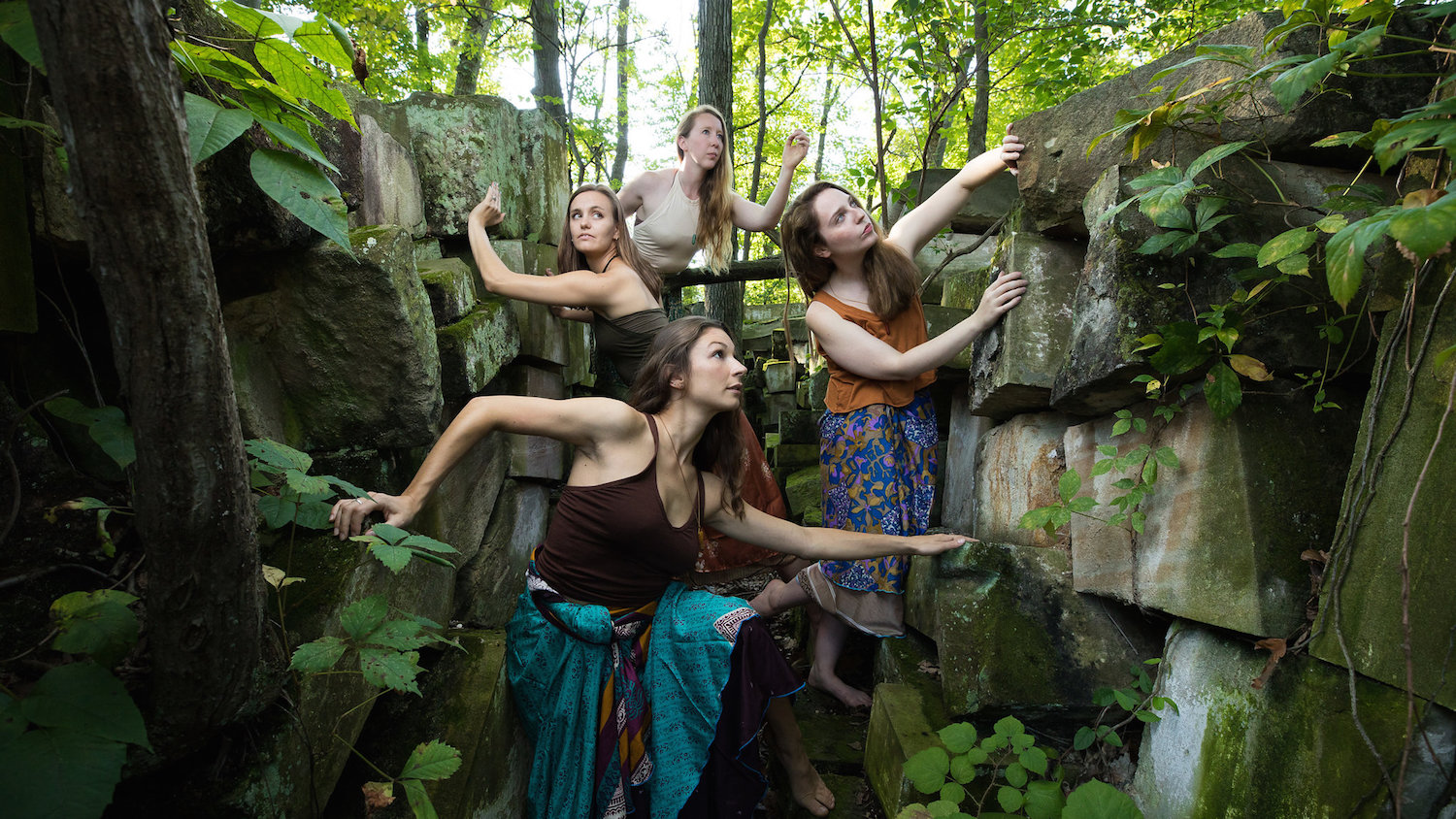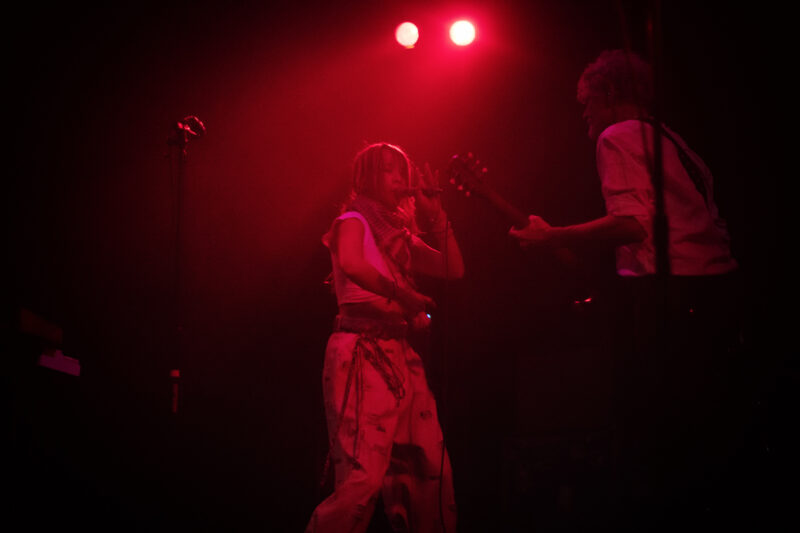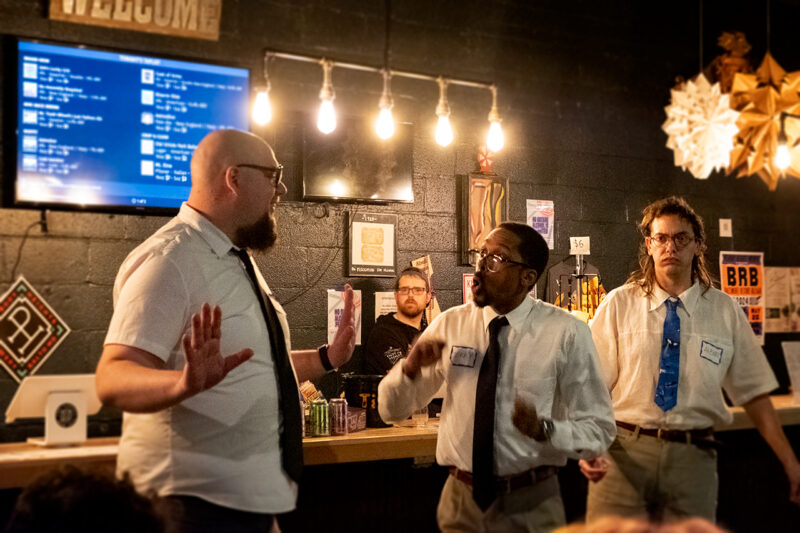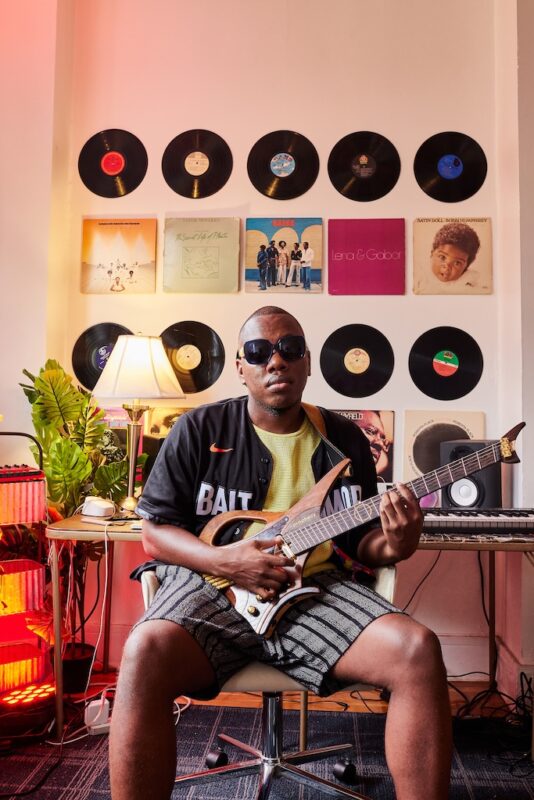A Baltimore-based Contemporary Dance Company Defies Tradition by Lauren H. Smith
For LucidBeings, to breathe is to dance. LucidBeings is a contemporary dance company that straddles the line between sensible and visceral. Their emotive performances embody nuance and illuminate contradiction, with contorted elegance and bodies piling onto each other to create a striking aesthetic. The company became official in 2017 and is owned and directed by artists Franki Graham and Jeanna Riscigno. They currently perform throughout Maryland, D.C., and Virginia.
I know Franki. I’ve been taking her contemporary dance class at Peabody Preparatory for a year so far. I was a dancer a long time ago, and she has helped me reconnect to movement as an art form and as an extension of being alive. Now, I can sense the strength of my body more acutely and trust the sturdy power of the ground beneath my bare feet. I can move with logic but also with freedom.
I interviewed Jeanna and Franki at the University of Maryland, Baltimore County (UMBC), where LucidBeings rehearses. We discussed their artistic journey, what it’s like to work as freelance dance artists and directors, and their devotion to each other — as colleagues and gal-pals “Jeans” and “Franks” — and to dancing with an artistic authenticity as much as possible.

Tell me about your background in dance.
Jeanna Riscigno: Franki and I are both from Frederick, Maryland. We didn’t grow up dancing together, but we both danced at local studios, training in all the forms. I focused on hip-hop in high school, but I spent a good amount of time focusing on ballet at Towson University. I studied abroad at Palucca Hochschule Conservatory in Dresden, Germany. And that is where — I just don’t know the words — it was such a stunning, life-changing experience! After Germany, I graduated from Towson, receiving my B.F.A. in Dance Performance. Then I moved to Los Angeles, where I danced on a cruise ship to save money and also danced with a couple of companies there, specifically a post-modern dance company called Benita Bikes Dance Art Company. I pretty much discovered early on that Los Angeles is a scene for commercial dancers, and I was far more interested in concert work, so I moved back to Maryland.
Franki Graham: I went to UMBC as a Linehan Artist Scholar. This is where it all started for me in terms of opportunities and learning what the dance world is outside of studio dance, which is very much a specific culture and way of thinking about things. I studied abroad in London at the Trinity Laban Conservatoire of Music and Dance for ten months. I came home to finish my last year of college and got my K-12 dance teaching certification. Then I went back over to London to get my master’s degree in Dance Performance as part of the Transitions Dance Company, where I was funded as a Leverhulme Scholar. I returned to Maryland and started teaching dance in public schools.
How did you two meet and later decide, “Hey, let’s start a dance company together”?
FG: Since we both grew up in Frederick, we knew of each other, but we didn’t have much interaction beyond dancing in one Nutcracker production put on by the touring Russian ballet. We ended up dancing together at Deep Vision Dance Company for a short amount of time. When both of us returned to Maryland after living elsewhere, we were struggling to figure out what our new relationship with dance was now that we didn’t have the community we worked so hard to build in other places.
FG: So we met for a ballet class and coffee, and we talked about working together. During our first couple of sessions in the dance studio, I think all we did was laugh! We both needed to be silly, have a dancing friend, and find some joy in dancing again. It also helped that we clicked instantly, so we started making work and dancing it in shows! And eventually, we decided we needed a name for what we were doing. So, LucidBeings came out of us wanting to explore our voices as choreographers and to dance in work that really spoke to us.
JR: We’ve known of each other since middle school. We even saw each other once in Europe. We were friends, but I think now our relationship has so much more depth.
FG: It felt a little superficial back then. We were just like, “Oh! You’re nice.”
JR: Yeah, and at that time, we were different dancers. But our experiences that brought us back to Maryland connected us, especially a shared idea of what we wanted out of dance and choreography and the creative process. We knew that we both still wanted to dance professionally and were hungry to create. And I think that’s what drove us close together. We were interested in very similar dance concepts and types of movement.
FG: We were like, “Oh my God — someone who wants it and understands it and realizes that in order to be a functioning human, we have to be dancing!” We wanted to make work that spoke to who we were as artists.
JR: We were/are all about staying true to our voice and what comes out of our process, and that seemed to be in alignment from the beginning.

Tell me about LucidBeings.
JR: The name came from my sister’s ability to “lucid dream.” She found empowerment within the awareness that she was dreaming and the ability to make choices within her dream. We paralleled these experiences to day-to-day living and asked ourselves: How many people are truly aware that they’re alive? And how many make conscious choices through life to embolden this experience of living? For Franki and me, the answer is always dance. Through movement, we feel more alive, more deeply connected to ourselves, each other, and the greater community of conscious beings.
JR: We make work that we hope is a catalyst for compassion, wonder, unity, and change. Many of our pieces celebrate the beauty, wonder, symbiotic relationship, and intelligence of nature. We are also fond of exploring philosophical and metaphysical ideas in an attempt to wrap our minds around specific concepts we find bewildering but important. We hope in some small way to unite the masses through these shared experiences and encounters of the untouchable and unknown. Lastly, I would say we also have a quirky, absurdist, comical side to our work. Through humor, we can make concepts more relatable, digestible, and enjoyable!
FG: The name really speaks to this idea that all human beings are part of a collective consciousness, and we as people have a gift, responsibility, and ability to live in this world with awareness and compassion. And for me, dance is a medium that can help us achieve that. Movement allows us to be fully present in the moment — to take a breath, feel, look around — and really be stewards of this earth. Personally, I see movement and dance as a way for people to break the cycles of routine and numbness that I think our current lifestyles cultivate. Our bodies have so much capacity and potential; I think awakening that allows for people to live fuller and freer lives.
What goes into the running of LucidBeings?
FG: Our work as directors often means responding to emails. We take care of the administrative work that allows us to fully engage in the artistic process when we’re in the studio together and with our company. We’re finding our home in the Baltimore dance scene and are looking for opportunities to perform or partner with other more established artists and companies in the area. We have been so lucky to work with some awesome people who have allowed our first year as an official company to be a success! In the dance world, it’s really all about the community.
FG: Having two artistic directors is a challenge that’s very specific to us, which other companies don’t necessarily have. We make all major decisions together and then divide the administrative work in ways that make sense, but often, our behind-the-scenes is texting or emailing about what we want to do for a specific gig or opportunity. But I love having a partner, and I couldn’t see it working any other way! We pick up each other’s slack, keep an eye on deadlines, and collaborate on creative decisions. It’s wonderful not to be in it alone. We always say that LucidBeings is Franki and Jeanna. So, at the end of the day, it’s our creative outlet. And checking emails is a labor of love.
JR: We’re two peas in a pod, the perfect yin and yang. We even share a bank account!
LS: Take me into your process of crafting a contemporary dance piece. What inspires your choreography, and how do you share that role?
FG: When we start a new process, we do a good bit of brainstorming and research to land on a concept we’re both passionate about. Our movement tends to use lots of partner work and contact improvisation. In one rehearsal, we realized we just needed to be physically connected to portray the reciprocity of nature we were working with, so we started rolling around on each other! This started to build and grow as we got more comfortable dancing in this way, and before we knew it, we were picking each other up and playing with our edges of strength and balance. So, partner work became pretty essential to our identity as choreographers.
FG: When we’re building a new piece, we try all the ideas we have and then edit. If we’re dancing in the piece, it can sometimes be challenging to have a critical, outside eye and still have the freedom to experiment as a dancer inside the frame. I think we will always need to navigate this delicate balance, but it’s rewarding for us personally. Luckily, we have awesome dancers who are supportive of this collaborative process!
JR: We allow a dance piece to take over and direct us. Many times, the work ends up having a mind of its own, and where we thought it was going is not actually what it needed or wanted to be. When you see us perform, you get to see the refined, rehearsed, finished product. But leading up to that, imagine a whole bunch of trial and error with bodies rolling and climbing and jumping on top of each other!
FG: By the way, we weren’t formally trained in contact improvisation. It’s not necessarily a part of dance training. If you graduate with a B.A. in dance, there’s a certain level of expectation that you’ve taken a ballet class and you’ve taken a modern class. But it doesn’t mean you’ve done partner work. I think that’s why we keep coming back to it. It’s something that’s really important to us and something we’re interested in.

How many total dancers are in LucidBeings? What’s it like all working on a piece together?
FG: We have nine now. We just got new members, and it’s so exciting! We just had our first rehearsal as a full group, and all of our dancers are incredible movers and excited to explore partnering. We feel so privileged to work with them! (Check out our Meet the Artists page to meet them! Our bios are pretty fun — they are written by people who love us!)
JR: Last year, we had five dancers: four, plus one understudy. Because all of our dancers wanted to be a part of our creative process, it was a very organic and energized dynamic. The studio is basically playground time for adult artists!
JR: Franki and I make all the decisions in the end, but we aren’t coming to rehearsal and being like, “Here’s the set piece. We’re gonna teach you the choreography.” We’ll guide our dancers by facilitating games, structured improvisation, activities, and exercises that lead us to material. Sometimes Franki and I have already built a phrase, but then we will all manipulate the heck out of it together. Our dancers are open and willing and excited about being a part of a process where they have a huge voice! Some companies do it the way we do, while others choose to put a piece on their dancers.
I know LucidBeings isn’t your only gig. What else do you two do for work?
FG: Part of starting this company for me was stepping away from a full-time job with traditional hours. I knew that to make it work, I needed to give LucidBeings the time and energy it needs to grow in its first few years. Now, we’re technically freelance artists. As you know, I have the privilege of teaching contemporary dance at the Peabody Preparatory, as well as directing the student Apprentice Company at Kinetics Dance Theatre. I’m excited to be teaching a Dance Teaching Methods course at UMBC this semester, too. The students in that class are working toward their K-12 teaching certification, which is the same program I went through. I’m also choreographing a few pieces for different student groups in Anne Arundel County and am subbing for some classes in different places. So, my work life is pretty flexible and allows me to continue making LucidBeings a priority.
JR: I work at 24/7 Dance Studio in Frederick as the owner’s assistant during the day and as a dance instructor for evening classes. I also work for Frederick County’s YMCA as the director for their Junior Dance Company. I used to be a full-time behavioral therapist for children with autism and was an active member of the field for 11 years. My goal is to merge my passion for special needs with my passion for dance. I want to create a dance therapy program or an adaptive dance program for children and adults with special needs.

How is LucidBeings transforming the contemporary dance scene?
FG: Whew, big question! I’m not sure if we’re transforming the contemporary dance scene, but we’re just trying to have a small part in it. Personally, I hope our art touches people. If we’re able to touch one person, or one thousand, it’s worth it. The way I see it, dance has always been my life journey. So, if we can make a difference along the way, I can’t really ask for more.
We’re also both really passionate about building a community and dance home for our dancers. Sometimes the dance community in Baltimore can feel very scattered, and finding that place to belong is so important. We want our dancers to feel valued (because they are!) and have a place to grow and thrive as artists. Jeans and I really want to dismantle the hierarchy of traditional dance companies. We want the dancers to feel as invested as we are and know that their voices are heard.
JR: Yes, as long as LucidBeings can provide a home and community for like-minded movers, plus captivate and open the minds of our audiences, I’m content. LucidBeings is sort of the opportunity and space to try out being the best version of yourself.
I think that from the beginning, we said we’re not going to try to be anything that we’re not. It’s okay to have a good sense of humor and not take yourself too seriously . . . but then also be open to making sure we’re bridging gaps within the dance community.
FG: We want to do good work, but at the end of the day, it’s more about the people aspect of it.
Tell me about your upcoming shows. Where and when can people see you perform?
FG: We’ve got a pretty awesome second season lined up! We just performed as part of The Collective’s Inside the Block, Outside the Box performance at the Creative Alliance on September 16. In November, we’ll work with a guest choreographer from DC, Katie Sopoci Drake, to restage a piece called “Crossings.” Additionally, we have other performances lined up at UMBC and Howard Community College. We are also working on an evening-length piece — our own show — to premier this spring in Baltimore and Frederick, so stay tuned for details! As soon as the dates for these events are confirmed, I’ll put them on our webpage calendar, so readers can always check that out for the most current information.
JR: Last year, we were guest artists for a ton of people’s shows. And with this year being our second season, we’re enthusiastic about producing our own evening-length show here in Maryland!
What else is on the horizon for LucidBeings?
FG: We’re exploring some exciting opportunities for research, classes, and workshops in the coming months and years. Mostly, we’re open for any opportunities that come our way! We do a lot of workshops, and we’re both super passionate about that. We kind of give a little taste of our creative process to different student groups. We just did a workshop for musicians called Movement for Musicians, and it was incredible.
JR: Movement for Musicians is one of the programs we would really love to take on the road to be “movement missionaries” and spread the love of dance to non-dancers. We’re really just trying to get the artist, the musician, the human to have a deeper relationship with their body and to trust other bodies in the space they share.
We also feel passionate about our contact improvisation and partnering workshops. And as I mentioned, it’s a big deal this year that we’re having our own show in the spring! We want to keep making work and continue collaborations, and one of our big future goals is to take our work nationally and internationally.
Upcoming: Franki Graham and Jeanna Riscigno will perform two LucidBeings duets as part of the Maryland Council for Dance Artists’ Concert 2018. The event will be held on Saturday, October 20th, 5:00-6:00 PM, in the Todd Performing Arts Center of Chesapeake College. Link with more info.
Author Bio: Lauren H. Smith is originally from a Georgia suburb and calls Baltimore City her home. She has a B.A. in Integrated Arts with Creative Writing Concentration from the University of Baltimore. She writes poetry and creative nonfiction and sometimes gets published in literary journals. Other times, she writes articles and edits people’s stuff. She also takes contemporary dance lessons, plays violin and sings, frequents arts events, doesn’t punderstand people who hate puns, and loves deep conversation — the heart-and-soul stuff that draws you toward the essence of someone’s being and longing, including your own.

